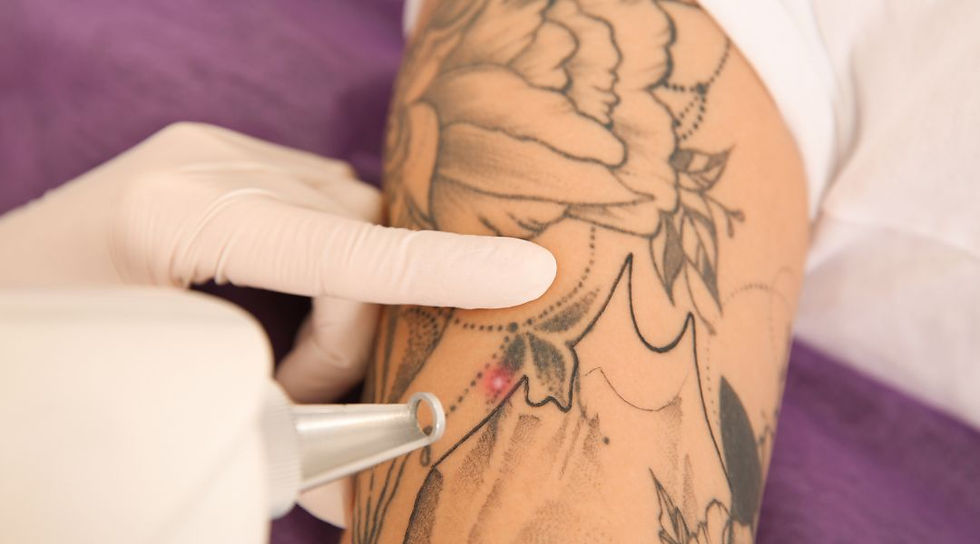Clear Skin Journey Laser Tattoo Removal Guide
- danyalmalikdynamic
- Aug 21, 2024
- 3 min read
Tattoos can be a powerful form of self-expression, but for various reasons, you might find yourself wanting to remove one or more tattoos. Whether it's due to a change in personal taste, a desire for clear skin, or professional considerations, laser tattoo removal has become a popular and effective solution. This guide will walk you through everything you need to know about Laser Tattoo Removal in Dubai, from how it works to what to expect during your journey.
Understanding Laser Tattoo Removal
How Laser Tattoo Removal Works
Laser tattoo removal involves using high-intensity laser beams to break down the ink particles in the skin. These lasers emit specific wavelengths that target the pigments in the tattoo ink. The laser energy is absorbed by the ink, causing it to fragment into smaller particles. Your body’s immune system then gradually removes these fragmented ink particles over time.
Different colors of ink absorb different wavelengths, so various lasers may be used depending on the colors in your tattoo. The most commonly used lasers are Q-switched lasers, which are effective in breaking down ink particles without causing significant damage to the surrounding skin.

Types of Lasers Used
Q-Switched Ruby Laser: Ideal for removing red and black ink. It operates at a wavelength of 694 nm and is particularly effective on certain ink colors.
Q-Switched Nd
Laser: Versatile and effective for a wide range of ink colors, including black and green. It operates at 1064 nm and 532 nm wavelengths.
Picosecond Lasers: These newer lasers deliver energy in picoseconds (trillionths of a second) rather than nanoseconds, allowing for more effective and quicker ink breakdown.
The Laser Tattoo Removal Process
Initial Consultation
Before starting the laser tattoo removal process, you’ll need to schedule a consultation with a dermatologist or a certified laser technician. During this visit, the specialist will evaluate your tattoo, discuss your goals, and determine the best laser type and treatment plan for you. They’ll also assess your skin type and medical history to ensure that you’re a good candidate for the procedure.
Treatment Sessions
Laser tattoo removal typically requires multiple sessions to achieve optimal results. The number of sessions needed depends on various factors, including the size and color of the tattoo, the depth of the ink, and your skin type. Generally, treatments are spaced 4-8 weeks apart to allow your skin to heal and the body to eliminate the ink particles.
During the treatment, you might experience some discomfort, similar to a rubber band snapping against your skin. The sensation varies from person to person, but many clinics offer numbing creams or local anesthesia to minimize pain.
Post-Treatment Care
After each laser session, your skin may appear red and swollen, similar to a mild sunburn. It’s important to follow the aftercare instructions provided by your specialist to ensure proper healing and minimize the risk of complications. This typically includes keeping the treated area clean, avoiding direct sunlight, and applying any recommended ointments.
Expected Results and Recovery
Healing Process
The healing process varies from person to person, but you can generally expect your skin to take 2-4 weeks to recover between sessions. During this time, the treated area may form scabs, which should not be picked or scratched. It’s also crucial to avoid exposing the area to excessive moisture or harsh chemicals.
Results
The results of laser tattoo removal can vary based on several factors, including the age and type of tattoo, skin type, and the colors of ink used. Most tattoos will lighten significantly after a series of treatments, though complete removal may not always be possible. Some tattoos may fade to the point where they are no longer noticeable, while others may leave behind a faint outline.
Potential Side Effects and Risks
Common Side Effects
While laser tattoo removal is generally safe, some side effects can occur. These include temporary redness, swelling, and discomfort in the treated area. Blistering and pigmentation changes (either lightening or darkening of the skin) are also possible but usually temporary.
Rare Risks
In rare cases, more serious complications may occur, such as infection or scarring. To minimize these risks, it’s crucial to choose a qualified and experienced practitioner, follow post-treatment care instructions, and avoid picking at or scratching the treated area.
Conclusion
Laser tattoo removal is a proven and effective method for achieving clearer skin and removing unwanted tattoos. Understanding the process, setting realistic expectations, and choosing a qualified practitioner are key to a successful removal journey. With proper care and a series of treatments, you can move closer to your goal of clear skin and a tattoo-free appearance.
Comments